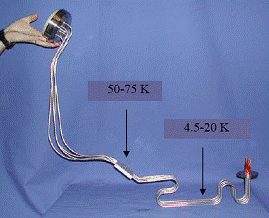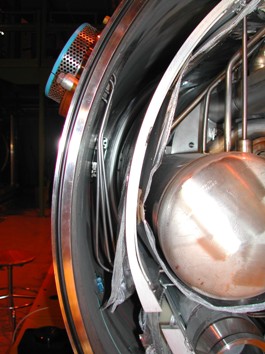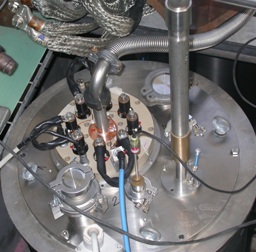|
The powering of
the LHC close orbit correctors will be made via 1504 current leads rated for a
maximum current of 60 A. Additional 520 current leads are needed for the
powering of the corrector magnets operating at currents of up to 120 A. At CERN, two different designs
were developed for these leads:
· a
conduction-cooled design, for all the 60 A leads and for part -324 in total- of the
120 A leads;
· a
gas-cooled design for the remaining 120 A current leads.
Conduction-cooled current leads
The
conduction-cooled current leads are integrated in the main vacuum insulation
of the LHC Short Straight Section (SSS) cryostats. They transport the
current from room temperature to the 1.9 K liquid helium bath. In view of
their important number and of the strong space constraints imposed by the
cryostat configuration, they are assembled in a group of four on a common
stainless steel flange. They are pre-shaped as requested by the integration
requirements, which require that these leads are the last components to be
integrated into the already densely packed LHC cryostats.
An hybrid
conductor, electrical insulated via a multilayer Kapton® tube, is first
inserted in a thin stainless steel tube and then pre-shaped with a tooling,
specially developed at CERN. The four tubes are finally welded to the warm
and cold stainless steel flanges. The hybrid conductor is a red brass rod that
is copper plated along the entire length with two different copper
thickness (thinner in the lower part). This hybrid conductor was chosen in order to minimize the heat
load into the helium bath while assuring good stability in case of thermal
run-away. The conductors of each assembly are thermalized against two heat
sinks that are fixed to two cryogenic lines carrying gas
at 50 K-75 K and at 5 K-20 K respectively. The heat sinking at intermediate
temperatures is made in order to minimize the heat losses into the liquid
helium bath.
The design of
these leads is extremely compact. It has the advantage, when compared to
conventional self-cooled leads, of not requiring warm valves and pipes for
the control and recovery of the helium flow. It avoids the use of cold
vacuum-tight ceramic feedthroughs. In addition, thanks to the material choice and to the good
design of the heat sinks, the leads have good thermal performance. The calculated
losses into the helium bath of the a 60 A current leads are < 90 mW
at 15 A, which is the average current estimated for these corrector
magnets, and 170 mW at maximum current. For comparison, a conventional
conduction-cooled current lead operating at 60 A would conduct about 2.5 W into the bath.
The predicted thermal and electrical performance of the 60 A current leads have been
confirmed by precise measurements performed on series components integrated in a
ad-hoc cryostat built in the
University of Southampton.
The series
production on the 60 A and 120 A conduction-cooled current leads is being
manufactured on the basis of a CERN "build-to-print" design respectively in
Mark&Wedell, Copenhagen, and in CECOM, Rome.
Gas-cooled current leads
The
gas-cooled current leads are integrated in cryostats, located in the
insertion regions of the LHC machine, which house also the HTS current
leads. They transport the current from room temperature to the 4.5 K liquid
helium bath. The design is very compact. Depending on the requirements of
the powering, the leads are assembled in groups of four or eight on a common
supporting flange. The novelty of this design with respect to conventional
self-cooled current leads consists in extracting the heat from the leads of
the same assembly via common heat exchangers, cooled by the gas produced by
the thermal conduction of the leads themselves at 4.5 K. This solution has
two important advantages: the reduction in the number of valves
needed for the cooling of the leads from one per lead to one per lead
assembly, with significant economical savings in particular in view of the
important number of leads, and the compactness of the design, which is made
possible also by the simplification of the cooling scheme. The thermal
performance of these leads is comparable to the one of conventional
self-cooled current leads optimized for the same current rating.
|

60 A Current Lead Assembly

60 A Current Lead Assembly in LHC cryostat

120 A current lead assembly in SSS cryostat

Cryogenic test, in ENEA, of 120 A
gas-cooled current lead
assembly (8 leads)

120 A gas-cooled current lead assembly |